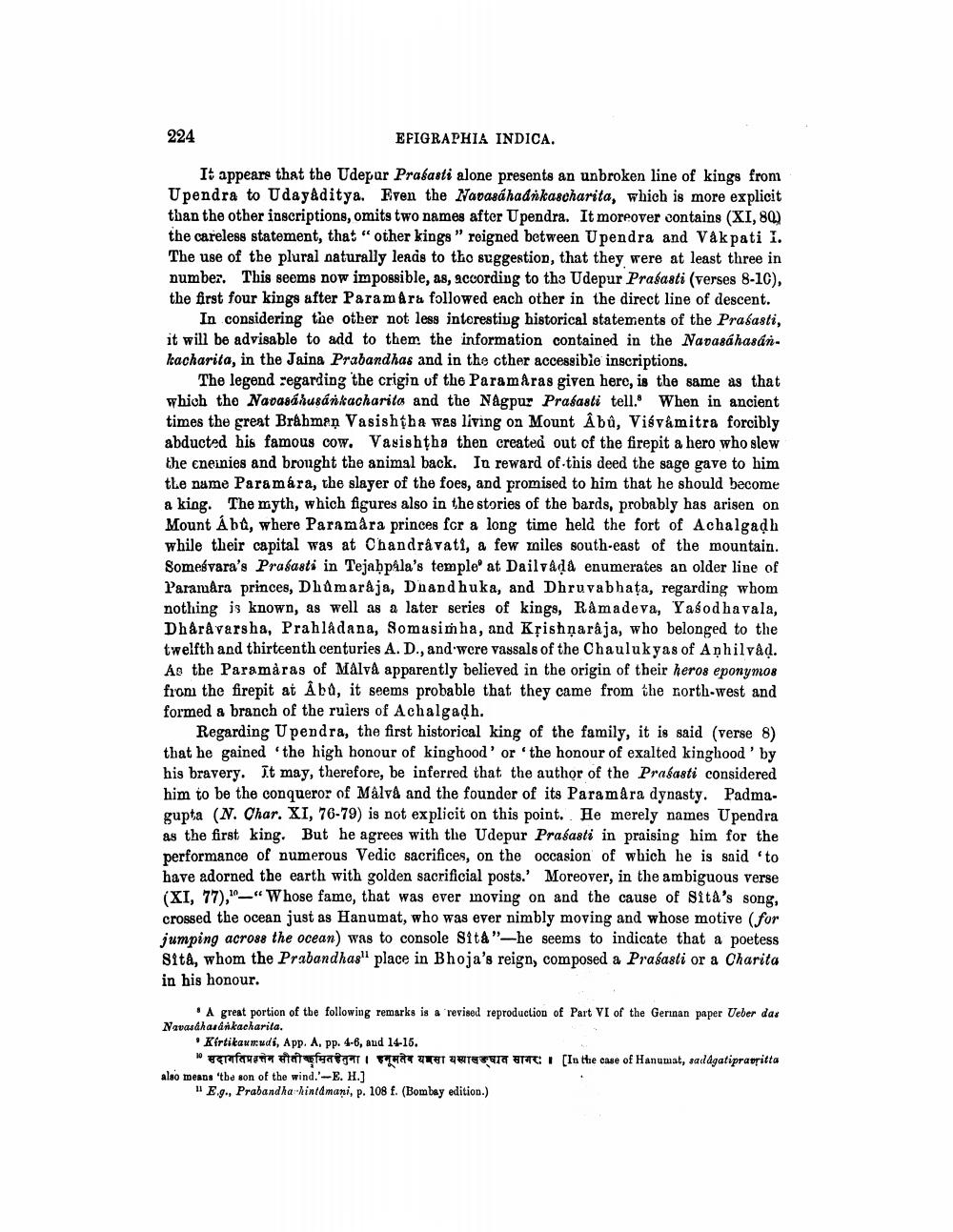________________
224
EFIGRAPHIA INDICA.
It appears that the Udepur Prasasti alone presents an unbroken line of kings from Upendra to Udayaditya. Even the Navasáhadnkascharita, which is more explicit than the other inscriptions, omits two names after Upendra. It moreover contains (XI, 80) the careless statement, that "other kings" reigned between Upendra and Våkpati I. The use of the plural naturally leads to the suggestion, that they were at least three in number. This seems now impossible, as, according to the Udepur Prasasti (verses 8-10), the first four kings after Paramara followed each other in the direct line of descent.
In considering the other not less interesting historical statements of the Prasasti, it will be advisable to add to them the information contained in the Navasáhasánkacharita, in the Jaina Prabandhas and in the other accessible inscriptions.
The legend regarding the crigin of the Paramaras given here, is the same as that which the Navasáhusánkacharita and the Nagpur Prasasti tell. When in ancient times the great Brahman Vasishtha was living on Mount Abû, Visvamitra forcibly abducted his famous cow. Vasishtha then created out of the firepit a hero who slew the cneinies and brought the animal back. In reward of this deed the sage gave to him the name Para mára, the slayer of the foes, and promised to him that he should become a king. The myth, which figures also in the stories of the bards, probably has arisen on Mount Abu, where Paramâra princes for a long time held the fort of Achalgaḍh while their capital was at Chandrâvati, a few miles south-east of the mountain. Somesvara's Prasasti in Tejaḥpâla's temple' at Dailvâda enumerates an older line of Paramara princes, Dhamaraja, Dhandhuka, and Dhruvabhața, regarding whom nothing is known, as well as a later series of kings, Ramadeva, Yasodhavala, Dhârâvarsha, Prahladana, Somasimha, and Krishnaraja, who belonged to the twelfth and thirteenth centuries A. D., and were vassals of the Chaulukyas of Anhilvâd. As the Paramaras of Malva apparently believed in the origin of their heros eponymos from the firepit at Abû, it seems probable that they came from the north-west and formed a branch of the rulers of Achalgaḍh.
Regarding Upendra, the first historical king of the family, it is said (verse 8) that he gained the high honour of kinghood' or 'the honour of exalted kinghood' by his bravery. It may, therefore, be inferred that the author of the Prasasti considered him to be the conqueror of Målva and the founder of its Paramâra dynasty. Padmagupta (N. Char. XI, 76-79) is not explicit on this point. He merely names Upendra as the first king. But he agrees with the Udepur Prasasti in praising him for the performance of numerous Vedic sacrifices, on the occasion of which he is said 'to have adorned the earth with golden sacrificial posts. Moreover, in the ambiguous verse (XI, 77),-"Whose fame, that was ever moving on and the cause of Sita's song, crossed the ocean just as Hanumat, who was ever nimbly moving and whose motive (for jumping across the ocean) was to console Sita"-he seems to indicate that a poetess Sitâ, whom the Prabandhas" place in Bhoja's reign, composed a Prasasti or a Charita in his honour.
A great portion of the following remarks is a revised reproduction of Part VI of the German paper Ueber das Navasahasankacharita.
'Kirtikaumudi, App. A, pp. 4-6, and 14-15.
" सदागतिप्रहतेन सौतीच्छुमितहेतुना । हनूमतेव यशसा यस्यालङ्घयत सागरः ॥ [ In the case of Hanumat, sadagatipravritta also means 'the son of the wind.'-E. H.]
"E.g., Prabandha hintamani, p. 108 f. (Bombay edition.)




